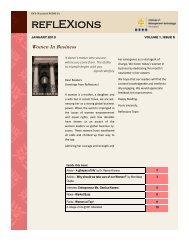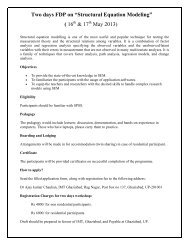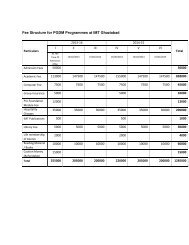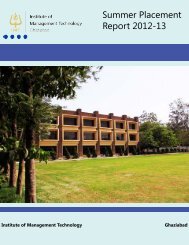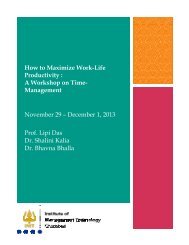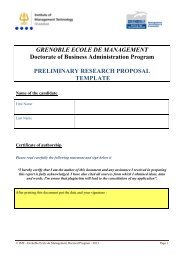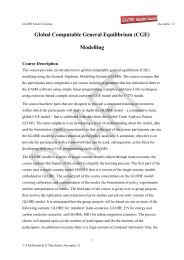Create successful ePaper yourself
Turn your PDF publications into a flip-book with our unique Google optimized e-Paper software.
14 Seshasayee Paper and Boards Limited (SPB) (<strong>2013</strong>). “The Company.” Retrieved from http://www.spbltd.com/profile.htm<br />
15 Singh, D.P., (2012). “Working Capital Management and Profitability in the IT and Telecom Industry in India.” Indian Journal of Finance,<br />
6 (3), pp.54-60.<br />
16 Zabiulla, ______ (2011). “Analysis of Profitability Ratios of Selected FMCG Companies in India.” The Journal of Indian Management &<br />
Strategy, 16 (1), pp. 18-20.<br />
V. Selvaraj<br />
Associate Professor and Head, Department of Commerce and<br />
Research Centre, Nehru Memorial College (Autonomous)<br />
Tiruchirappalli Dt., Tamil Nadu.<br />
selva_velva@yahoo.co.in<br />
P. Rajangam<br />
Assistant Professor and Head, PG Department of Commerce,<br />
Government Arts College, Ariyalur - 621 713, Tamil Nadu.<br />
raja_72cbe@yahoo.co.in<br />
Order Reprints<br />
AN ANALYSIS OF EARNINGS MANAGEMENT IN INDIA : AN EMPIRICAL STUDY<br />
Abstract:Indian Journal of Finance, Volume 7, Number 6, pp. 45 - 55<br />
Using a sample of 1,035 company year observations for the years 2006 to 2010, an effort has been made in the present study to assess<br />
the magnitude of earnings management through accruals estimation. The study investigates the overall breadth and scope of earnings<br />
management behavior in a broader context through a comprehensive analysis of reported earnings across Indian industry sectors and<br />
individual company characteristics. The results affirmed that earnings management as depicted by discretionary accrual exists in the Indian<br />
companies. The results provide some evidence to the fact that earnings management has an unfavourable effect on the value of the<br />
company.<br />
Keywords: earnings management, discretionary total accruals, company characteristics<br />
JEL Classification: M 49<br />
References<br />
1 Ayres, F.L. (1994). “Perceptions of Earnings Quality: What Managers Need to Know.” Management Accounting, 75 (9), pp. 27-29.<br />
2 Bartov, E., Gul, F.A., & Tsui, J.S.L. (2001). “Discretionary Accruals Models and Audit Qualifications.” Journal of Accounting and<br />
Economics, 30 (3), pp. 421-452.<br />
3 Bathke, A. W., Lorek, Jr. K. S. & Willinger, G.L. (1989). “Firm-size and the Predictive Ability of Quarterly Earnings Data.” The<br />
Accounting Review, 64 (1), pp.49-68.<br />
4 Beasley, M. S. (1996). “An Empirical Analysis of the Relation between the Board of Director Composition and Financial Statement<br />
Fraud.” The Accounting Review, 71(4), pp.443-465.<br />
5 Beasley, M. S., Carcello, J.V., Hermanson, D.R., & Lapides, P.D. (2000). “Fraudulent Financial Reporting: Consideration of Industry<br />
Traits and Corporate Governance Mechanisms.” Accounting Horizons, 14 (4), pp. 441-454.<br />
6 Bertin, J., Alejandro, M., Iturriaga, L., & Félix, J. (2007). “Earnings Management and Internal Control Mechanisms: Evidence from<br />
Chilean Firms.” Retrieved from http://ssrn.com/abstract=849104<br />
7 Breton, G., & Stolowy, H.A. (2000). “Framework for the Classification of Accounts Manipulations.” HEC Accounting & Management<br />
Control Working Paper No. 708/2000, Retrieved from http://ssrn.com/abstract=263290<br />
8 Burgstahler, D., & Dichev, I. (1997). “Earnings Management to Avoid Earnings Decreases and Losses.” Journal of Accounting and<br />
Economics, 24 (3), pp. 99-126.<br />
9 Chen, J. (2001). “Ownership Structure as Corporate Governance Mechanism: Evidence from Chinese Listed Companies.” Economics of<br />
Planning, 34, pp.53-72.<br />
10 Chen, K.Y., Elder, R.J., & Hsieh, Y.M. (2007). “Corporate Governance and Earnings Management: The Implications of Corporate<br />
Governance Best-Practice Principles for Taiwanese Listed Companies.” Journal of Contemporary Accounting and Economics, 3(2),<br />
Retrieved from http://ssrn.com /abstract=98196<br />
11 DeAngelo, L. (1986). “Accounting Numbers as Market Valuation Substitutes: A Study of Management Buyouts of Public Stockholders.”<br />
The Accounting Review, 41(3), pp.400-420.<br />
12 Dechow, P. M., & Skinner, D.J. (2000). “Earnings Management: Reconciling the Views of Accounting Academics, Practitioners, and<br />
Regulators.” Accounting Horizons, 14(2), pp.235- 250.<br />
13 Dechow, P.M., Sloan, R.G., & Hutton, A.P. (1996). “Causes and Consequences of Earnings Manipulation: An Analysis of Firms Subject<br />
to Enforcement Actions by the SEC.” Contemporary Accounting Research, 13(2). Retrieved from http://ssrn.com/abstract=2607<br />
14 DeFond, M.L., & Jiambalvo, J. (1991). “Incidence and Circumstances of Accounting Errors.” The Accounting Review, 66 (3), pp.643-<br />
655.<br />
15 Healy, P. M., & Wahlen, J.M. (1999). “A Review of the Earnings Management Literature and Its Implications for Standard Setting.”<br />
Accounting Horizons, 13 (4), pp.365 - 383.<br />
16 Iturriaga, F.J., & Hoffman, S.P. (2005). “Managers' Discretionary Behaviour, Earnings Management and Internal Mechanisms of<br />
Corporate Governance: Empirical Evidence from Chilean Firms. Retrieved from http://ssrn.com/abstract=739246<br />
17 Iqbal, A., & Strong, N. (2010). “The Effect of Corporate Governance on Earning Management around UK Rights <strong>Issue</strong>s.” International<br />
Journal of Managerial Finance, 6 (3), pp. 168-189.<br />
18 Jaggi, B., & Lee, P. (2002). “Earnings Management Response to Debt Covenant Violations and Debt Restructuring.” Journal of<br />
Accounting, Auditing and Finance, 17(4), pp.295-324.<br />
19 Jiraporn, P., & Gleason, K.C. (2007). “Delaware Incorporation and Earnings Management: An Empirical Analysis.” Journal of Applied<br />
Finance , 51 (1), pp.40-51.



